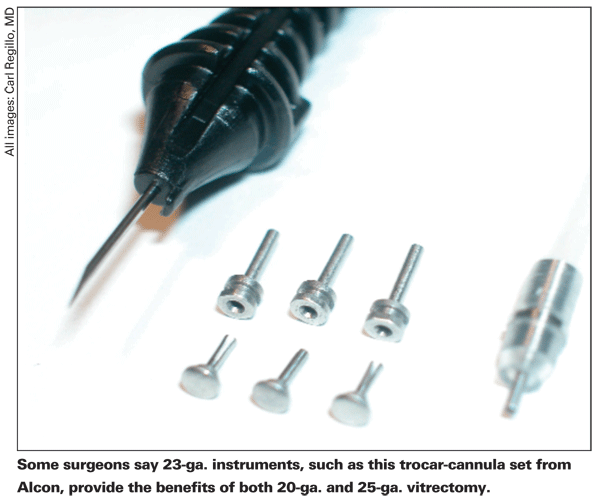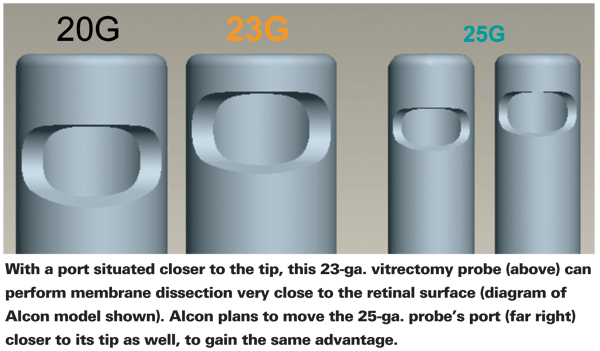Though there appears to be a trend toward small-gauge, sutureless vitrectomy among retinal surgeons, there are still questions about small-gauge surgery that need to be addressed before more surgeons embrace it. Though 25- and 23-ga. surgeries result in less discomfort and inflammation for patients, they may also increase the risk of complications associated with vitrectomy. Here, several experienced retinal surgeons share their views on the small-gauge debate and the direction they think vitrectomy is headed.
Advantages of 23-Gauge Surgery
Some surgeons think that the most recent addition to the vitrectomist's arsenal, 23-ga. instruments, combines the best of 20-ga. (relatively higher flow rates and stiffer instruments) and 25-ga. devices (sutureless wounds that are much less irritated and inflamed postop). Some also feel that sutureless surgeries are faster than 20-ga., though others don't think this is true for all cases.
"There's a definite continued trend toward smaller incision vitrectomy," says
Dr. Regillo also feels 23-ga. surgery is faster than 20 ga., and may be faster than 25 ga., based on a prospective, multicenter study led by himself and his Wills Eye colleague, Allen Ho, MD. The paper has just been conditionally accepted for publication, so not all the details are available yet. Dr. Regillo will say, however, that the surgeons' mean operative time was around 30 minutes for vitrectomies for various indications, most of which were simpler cases. "I don't mean to imply, however, that all cases will take a half an hour," he notes. He says the surgeon saves a lot of time in the beginning and end of the vitrectomy by going sutureless. "I'd say 23 is the fastest because you save time on opening and closing, which was the advantage of 25 over 20," says Dr. Regillo, "and, to me, it removes vitreous gel just as fast as 20 ga. and allows you to manipulate the eye as easily as 20 ga."
Vienna
"Concerning 25 ga., which was promoted as being faster than 20 ga., when we measured the total surgical time there was no difference if you removed the same amount of vitreous," Dr. Binder says. "This means with 25-ga., you gain time at the beginning and end of surgery, but you lose some during the vitrectomy due to the smaller instruments taking a bit longer to remove vitreous. The results were the same with 23 ga., though the difference between it and 20 ga. in removing the vitreous wasn't as pronounced. But it was still there."
She says that patient comfort was significantly higher with both small gauges compared to 20 ga., and that pain and redness were significantly lower in the small-gauge patients.
In terms of complications, the rate of hypotony was significantly higher in the smaller-gauge groups in Dr. Binder's study in the first postop week, but then it resolved. There were three choroidal hemorrhages in the 23-ga. group that she ascribes to postop hypotony. "This wasn't a cluster," she says. "There were four surgeons and three of us had one hemorrhage each in the first half of the study. But then we talked about it, learned to keep the pressure higher, and the complication didn't recur." Dr. Regillo reports a hypotony rate with 23 ga. that's comparable to 25-ga., around 6 to 8 percent. "It tends to be well-tolerated in general, and almost always resolves spontaneously within a week," he says.
Dr. Binder initially used 25 ga., but now prefers to use the stiffer 23-ga. instruments for most of her vitrectomies. "In
"I also use 20 ga. for all of my subretinal surgery," Dr. Binder adds. "Though there's not much indication for subretinal work anymore, if you have to go subretinal and need bent instruments, then you can't use small-incision instruments because angled instruments only come in 20 ga." She says she hasn't abandoned 25-ga. either, using it for anterior segment complications where she doesn't want to make a large incision, as well as in pediatric cases. "It's really easy to make a very small paracentesis and do a little vitrectomy to cut a vitreous strand," she says. "You don't need very much infusion and you don't have to close with a suture."
Dr. Regillo also uses 20 ga. in select cases. "I'll still do 20 ga. for bad trauma, where I'm opening up the conjunctiva anyway, and certain complicated retinal detachments, especially if it's a reoperation where I'm using oil," he says. "It has to do with the level of complexity. If I'm opening the conjunctiva anyway, such as when I'm placing a buckle in a combined case, I'm not saving much time with 23-ga. at that point."
The Case for 25 Gauge
Memphis, Tenn., surgeon Steve Charles also likes small-gauge surgery, but takes an opposite view to that of the 23-ga. proponents: Twenty-three gauge isn't the best of both worlds, but rather is a transition between 20 ga. and what he considers the ideal size, 25 ga. Dr. Charles is a consultant for Alcon, and helped develop the company's Accurus vitrectomy system.
"Did 23 ga. address the instrument stiffness and flow-rate issues some doctors had with 25 ga.? Absolutely," says Dr. Charles. "The 23-ga. system moved the port closer to the tip and went from 1,500 to 2,500 cuts per minute, so some surgeons have determined that there are now more reasons to do 23 ga. instead of 25 ga., and the number of 23-ga. users is starting to rise." However, he argues that the 25-ga. wounds are much smaller, seal better and irritate the conjunctiva less than 23-ga., which were the main reasons to do small-gauge vitrectomy in the first place. "The 23-ga. wounds are 50 percent bigger, 0.75 mm instead of 0.5 mm, so it's a huge difference," he avers. He also says there is 25-ga. instrumentation in the pipeline that will have a higher cutting rate that will close the gap with 23-ga. "The new technology has such extraordinary flow control because of the fast cutting rates that it's far healthier for the eye because you're not pulling on the retina," Dr. Charles says. "You have to take the port to the vitreous and therefore have much less of a chance of a retinal break."
Unanswered Questions
If small-gauge vitrectomy were perfect, everyone would be doing it. That's not the case, however. Some surgeons say small-gauge surgery still needs to deal with issues of both technique and complications before it completely overtakes 20-ga. surgery.
Chief among the issues with small-gauge is the possibility that it carries a greater risk of endophthalmitis compared to 20-ga. This potential problem came to the fore with the publishing of an article in the December 2007 issue of Ophthalmology.1 In it, surgeons from Wills Eye Hospital's retina service compared the rate of postop endophthalmitis associated with 3,103 consecutive 25-ga. surgeries with that of 5,498 20-ga. procedures performed at the hospital between January 1, 2004 and September 1, 2006. They found one case of endophthalmitis in the 20-ga. group (0.018 percent) vs. seven in the 25-ga. group (0.23 percent; p=0.004), a statistically significant incidence that was 12 times higher. Though a similar study hasn't been carried out for the relatively new 23-ga. procedure, some surgeons worry that it, too, will have a higher incidence of postop endophthalmitis compared to 20-ga. surgery, due to the fact that the wounds, as in 25-ga. surgery, aren't sutured postop.
Edina
Dr. Williams says that, in a series of 330 consecutive 25-ga. cases, the incidence of endophthalmitis was 0.8 percent, compared to 0 in 300 consecutive 20-ga. cases. He also says that he experienced a higher rate of postop retinal detachment (3 percent) in a series of over 300 25-ga. surgeries for routine epiretinal membrane removal compared to an incidence of just 0.6 percent for around the same number of 20-ga. surgeries for the same indication. The mechanism behind these detachments is unclear, and he acknowledges that he hasn't seen anyone else report such a disparity in terms of detachment rates. "Endophthalmitis, however, is another story," he says. "There have been presentations at major meetings and published reports of an increased incidence of endophthalmitis after 25-ga. surgery compared to 20 gauge." He thinks this trend will continue with 23-ga. procedures, as well.
"Certainly, small gauge doesn't allow you to do any more than you would with standard 20-ga. surgery," says Dr. Williams. "So, from that standpoint, 23 and 25 ga. don't have any advantages … Twenty-gauge surgery is well-established, long-established and has an excellent safety record. I think a surgeon can, without question, continue doing 20-ga. vitrectomies and still be state-of-the-art."
Richard Kaiser, MD, was one of the authors of the Wills Eye study that found the 12-fold greater incidence of postop endophthalmitis with 25 ga. He says the results spurred him to action. "The incidence is still very low, thus I'm not saying the surgery is unsafe," he says. "But I do think it's something we have to be aware of so we can do everything possible to minimize it. One of the things I did was form the Microsurgical Safety Task Force, a group of leaders in the field of vitreoretinal surgery, such as George Williams, Harry Flynn, Sandy Brucker, Allen Ho and several other prominent retina surgeons. We met several times to break down each step of the small-gauge, sutureless procedure to try and identify key steps that may help minimize complications from the surgery." The task force formulated a list of several suggestions that surgeons can take to help minimize the risk, and it's due to be presented at this year's Retina Subspecialty Day at the
Dr. Kaiser provided a summary of some of the main points of the task force's list: "Pay close attention to wound construction," he says. "Consider doing an air/fluid exchange at the end of the case because most of the endophthalmitis cases that were reported in our series at Wills and in a couple of other series were fluid-filled vs. air-filled at the end of the case. Our belief is that an air-filled eye maintains a more consistent pressure at the end of the case, which could possibly decrease the influx and efflux of fluid through the wound. And, having a higher pressure helps seal the wound better. We're not saying these suggestions are the answers to endophthalmitis, but even small changes in the procedure could improve the complication rate.
"Obviously, we want to try to do everything we can, but no one has the right answer," Dr. Kaiser continues. "Perhaps the right answer is to stick with 20 ga., but I don't think that's the trend and I don't think that's where people are going with it. If you look at other surgeries in ophthalmology, such as cataract surgery, there have been increases in the incidence of endophthalmitis along the way as new techniques have come out. In the change from extracapsular cataract extraction, which involved suturing the wounds, to sutured corneal wounds and then to clear corneal wounds, there were two- and threefold increases in endophthalmitis and other complications until surgeons perfected the technique. We, as retina surgeons, have an obligation to continue to move our field forward in a safe and efficacious manner."
Dr. Binder also draws a parallel between sutureless vitrectomy and cataract surgery. "We haven't solved all the problems with small-gauge surgery, and we need to see if there's a higher risk of endophthalmitis," she says. "But, even so, we'll learn to deal with these complications. This was the same with cataract surgery and clear corneal incisions, and now we use antibiotics to prevent infection with cataract surgery. I think we'll learn to cope with the problems."
Pravin Dugel, MD, of
"The wound construction is much less forgiving than it is with 25 ga.," says Dr. Dugel. "So, unless you pay very good attention to wound construction, you have more of a risk for hypotony and wound leak. And it's possible, though it's not been proved or disproved, that if you have more wound gape and hypotony, you might theoretically have a higher rate of endophthalmitis." To make a good wound with a 23-ga. instrument, Dr. Dugel concentrates on three things: displacing the conjunctiva so the hole in the conjunctiva is away from the scleral hole; angling the incision so that it will self-seal; and making sure there's an internal tamponade at the end of the case.
Dr. Regillo agrees that the 23-ga. wound construction is crucial. "With 23 ga., you have to be more meticulous with wound construction," he says. "The angle is much steeper and shallower to the tangent of the eye than with 25 ga. The angle of the wound helps make the wound shelved, and the shelving acts as a valve. You're creating a valve effect that's important for having the wound be watertight at the end of the case. You have to be much more attentive to the creation of the wounds for them to be adequately sealed later. There's a little bit more tension involved with creating the wound, and a little bit of a learning curve associated with stabilizing the globe in order to get the very shallow angle with 23 ga. There's a smaller margin for error in terms of placing the trocars just right."
Rather than supplanting 20-ga. vitrectomy, perhaps small-gauge surgery will complement it. "I think small-incision surgery is here to stay," says Dr. Binder. "However, I don't think it makes sense to be exclusive and say, 'I'm only using 25 or only 23,' or, 'I'm never using 20 again,' because each size is helpful and you have to adapt to the case at hand. If I were a patient, I'd want my surgeon to do a safe surgery with little pain, but not a surgery in which he uses something that's not sufficient."
1. Kunimoto DY, Kaiser RS, Wills Eye Retina Service. Incidence of endophthalmitis after 20- and 25-gauge vitrectomy. Ophthalmology 2007;114:12:2131-2.




